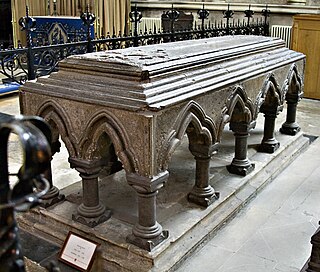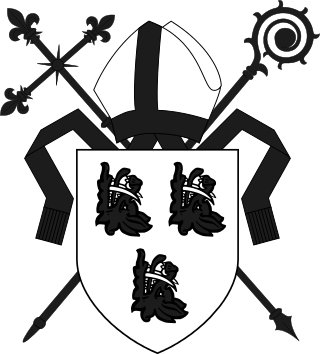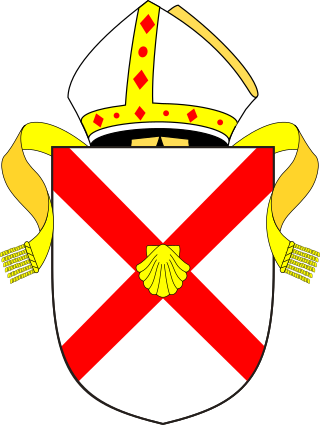Related Research Articles
Robert of Ghent, also called Robert de Gant, was Lord Chancellor of England and Dean of York in the 12th century. The younger son of a nobleman, Robert was probably a member of the cathedral chapter of York before his selection as chancellor by King Stephen of England in the mid-1140s. He is not mentioned often in documents from his time as chancellor, but why this is so is unknown. He became dean at York Minster around 1147. Robert was slightly involved in the disputes over who would be Archbishop of York in the late 1140s and 1150s, but it is likely that his chancellorship prevented his deeper involvement in diocesan affairs. He was no longer chancellor after the death of Stephen, but probably continued to hold the office of dean until his death around 1157 or 1158.

Roger Northburgh was a cleric, administrator and politician who was Bishop of Coventry and Lichfield from 1321 until his death. His was a stormy career as he was inevitably involved in many of the conflicts of his time: military, dynastic and ecclesiastical.
John Chishull or John de Chishull was Lord Chancellor of England, Bishop of London, and Lord High Treasurer during the 13th century. He also served as Dean of St Paul's.

Sewal de Bovil was a medieval Archbishop of York.

Lawrence Booth served as bishop of Durham and lord chancellor of England, before being appointed archbishop of York.

The Bishop of Rochester is the ordinary of the Church of England's Diocese of Rochester in the Province of Canterbury.
The Archdeacon of Canterbury is a senior office-holder in the Diocese of Canterbury. Like other archdeacons, he or she is an administrator in the diocese at large and is a canon residentiary of the cathedral.
Richard de Belmeis was a medieval cleric, administrator and politician. His career culminated in election as Bishop of London in 1152. He was one of the founders of Lilleshall Abbey in Shropshire.

St Peter's Collegiate Church is located in central Wolverhampton, England. For many centuries it was a chapel royal and from 1480 a royal peculiar, independent of the Diocese of Lichfield and even the Province of Canterbury. The collegiate church was central to the development of the town of Wolverhampton, much of which belonged to its dean. Until the 18th century, it was the only church in Wolverhampton and the control of the college extended far into the surrounding area, with dependent chapels in several towns and villages of southern Staffordshire.

The Archdeacon of Bedford is an ecclesiastical post in the Church of England Diocese of St Albans in the Province of Canterbury. Historically the post was in the Diocese of Lincoln, then from 1837 in the Diocese of Ely, England. On 13 April 1914, the archdeaconry became a part of the Diocese of St Albans. The present holder of the office is Dave Middlebrook, collated Archdeacon on 30 March 2019.
The Archdeacon of Buckingham is the senior ecclesiastical officer in charge of the Church of England in Buckinghamshire.
Robert de Stretton was Bishop of Coventry and Lichfield following the death of Roger Northburgh in 1358. A client of Edward, the Black Prince, he became a "notorious figure" because it was alleged that he was illiterate, although this is now largely discounted as unlikely, as he was a relatively efficient administrator.
Thomas Kent was the Archdeacon of Totnes. According to one source he held the post during 1549. This Thomas Kent has been tentatively identified with the Thomas Kent of the period who was canon of Christ Church, Oxford, and who died in 1561–2. That Thomas Kent was also rector of Marsh Gibbon from 1546. The CCEd database makes Thomas Kent archdeacon of Totnes only in 1562; being rector of Tedburn St Mary and Holsworthy.
Charles Booth, D.C.L. was a sixteenth-century clergyman who served as the Bishop of Hereford from 1516 to 1535.
William Witham was incumbent at St Marylebone until 12 November 1454, when he exchanged the office for that of Archdeacon of Stow. He was then Archdeacon of Leicester, Dean of Arches and Dean of Wells until his death before 1473.
William Fitzilliam or Fitzjames was Dean of Wells Cathedral from 1540 to his resignation and surrender of the Deanery in late 1547.
The Archdeacon of Llandaff is a senior ecclesiastical officer in the Church in Wales Diocese of Llandaff. The archdeacon is the senior priest with responsibility over the area of the archdeaconry of Llandaff, one of two archdeaconries in the diocese. The archdeaconry of Llandaff currently consists of two large deaneries: Cardiff, and Eglwysilan.
Hamo was a 12th- and 13th-century English cleric. He was the Diocese of York's dean, treasurer, and precentor, as well as the archdeacon of the East Riding. His background is unknown, but he was probably a canon of the cathedral chapter at York Minster by 1171. He claimed to have been treasurer of the chapter by 1189, but did not actually hold the office until 1199. Hamo clashed with his archbishop, Geoffrey several times, and when Geoffrey died, Hamo's fellow canons were forbidden by King John of England from electing Hamo to succeed Geoffrey. Hamo died sometime after 1219, when he was last attested as holding his final office, dean.
Robert de Mariscis(Robert Marsh) was a Priest in the Roman Catholic Church.
John Hovyngham, also written Honyngham or Ovyngham, was an English clergyman, notary, diplomat and Archdeacon of Durham.
References
- ↑ "The history and antiquities of Somersetshire" Phelps, W: London, J.B. Nichols & Son, 1839
- ↑ "A concise history of the Cathedral Church of Saint Andrew, in Wells" Camp, J.M.F: Shepton Mallet, W.J. Quartley, 1814
- ↑ "Cathedral Antiquities: Wells, Exeter, and Worcester" Britton, J London M. A. Nattali, 1836
- ↑ Calendar of Patent Rolls, April 11 1401 Leeds castle
- ↑ British History On-line
- ↑ Fasti ecclesiae Anglicanae Vol.2 p75
- ↑ Genuki Archived 2011-11-08 at the Wayback Machine
- ↑ Willis, Browne (1755). The history and antiquities of the town, hundred, and deanery of Buckingham. Vol. 2. p. 74.
- ↑ Fasti ecclesiae Anglicanae Vol.2 p220
- ↑ William Page, ed. (1908). "The parishes of Aylesbury hundred: Aston Clinton". A History of the County of Buckingham: Volume 2. Institute of Historical Research. Retrieved 28 January 2013.
- ↑ University of Iowa
- ↑ "Vicars of St. Michael's Church & Cathedral, Coventry". Historic Coventry. Rob Orland. Retrieved 16 August 2012.
- ↑ "Petition by Henry Bowet, bishop of Bath and Wells; Thomas Rempston, knight". National Erchives. Retrieved 16 August 2012.